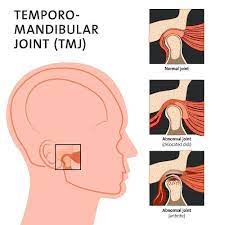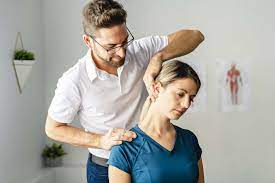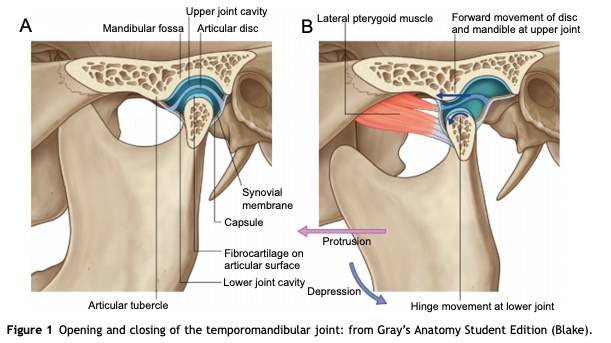Did you know that the most common motor dysfunction (in terms of disability) is TMJ disorders? There are lots of exercises out there that could help, but not all of them work for everyone. This article will tell you what TMJ physical therapy is, how to do it, and which exercises are best.
Contents
What is TMJ?

TMJ (temporomandibular joint) is a group of three bones that connect the skull to the mandible. It’s responsible for moving your jaw and can become dysfunctional from a variety of causes, such as arthritis, injury, or genetics. Physical therapy (PT) can help relieve symptoms and improve function.
PT focuses on restoring the normal range of motion (ROM) in the TMJ, improving muscle function, and treating pain. The best exercises for TMJ physical therapy focus on stretching and mobilizing the joint while avoiding pain.
About TMJ Physical Therapy
TMJ physical therapy is a type of rehabilitation that helps to improve the function of the temporomandibular joint (TMJ). The TMJ is located in the neck and helps to move the jaw. It can sometimes become swollen and cause pain. Physical therapy can help to improve the function of the TMJ by helping to restore movement and reduce pain.
Physical therapy for TMJ usually involves a combination of exercises and stretches. Exercises may include stretching exercises, massage, or manipulation. Stretches may involve using an elastic band or a piece of cloth to stretch the muscles in the neck. Some people also use splints to help maintain their range of motion and relieve pain.
Physical therapy may also include using devices such as tennis balls or foam rollers to apply pressure to specific areas of the neck. This can help to release tension and relieve pain. Sessions typically last about 30 minutes each, and are repeated every couple of weeks until improvement is seen.
Benefits of TMJ Physical Therapy
TMJ Physical Therapy is a type of therapy that is used to treat various disorders and conditions, such as TMJ (temporomandibular joint) pain, temporomandibular disorder (TMD), neck pain, headache, and jaw pain.
TMJ physical therapy can help to relieve the symptoms of these conditions by improving the function of the temporomandibular joint (TMJ). In addition to treating TMJ pain and dysfunction, physical therapy may also improve other symptoms related to the disorders or conditions.
Physical therapy for TMJ typically includes a combination of massage, exercise, and adjustments to the jaw. The therapist will determine which exercises are most effective for you based on your symptoms and condition.
Some of the benefits of TMJ physical therapy include:
- relief from TMJ pain and dysfunction
- improvement in other symptoms related to the disorder or condition
- improvement in the function of the TMJ
If you are experiencing pain or discomfort in your jaw, physical therapy may be a good option for you. There are many different types of physical therapy that can help to improve your condition. If you are considering TMJ physical therapy, be sure to speak with a therapist about your specific needs.
Different Types of TMJ Physical Therapy

Physical therapy for temporomandibular joint (TMJ) issues typically involves the use of various exercises and stretches to improve function. There are main types of TMJ physical therapy
Conservative therapy
It involves managing symptoms without seeking surgery or other invasive treatments.
Rehabilitative therapy
It aims to restore lost function and may require a combination of exercises and stretches.
Manual physical therapy
It is different than other treatments because it focuses on hands-on techniques that can improve joint motion and reduce muscle stiffness, and trigger points near the jaw to relieve stress on the disk and joint.
Trigger Point Dry Needling
One of the many types of trigger point therapy is Dry Needling. This therapeutic treatment has been shown to be effective in treating these tender and tightly-knit trigger points that can cause headaches. If effective, this procedure will release the muscle spasm and your jaw will return to a relaxed state right away.
Stretching
Stretching the mouth, neck, and face can help to reduce tension and inflammation in these areas.
Massaging
Massaging the temporal (side) muscles can help to relieve pain and improve function.
Best Exercises to Treat TMJ Problems
There are many different exercises that can be used to treat TMJ problems. Some common exercises include:
Chewing muscles
This exercise helps to loosen up the jaw and reduce tension in the jaw muscle.
Resting your jaw
This is a simple but important exercise that should be done regularly to help improve TMJ function. Simply rest your jaw in an open position for 30 seconds or more every day.
Tapping
Tap your chin with your fingertips twice quickly. Hold for two seconds and repeat on the other side. This exercise helps stretch the Temporomandibular Joint capsule and promote better chewing function.
Wall Squats
Stand with feet shoulder-width apart and hold a weight in each hand at arm’s length back behind you, with palms facing forward. Keeping your back straight, squat down as low as possible until your thighs are parallel to the ground then push yourself up to a standing position. Repeat 10 times on each side. This exercise strengthens muscles around the jaw and helps improve ROM in the TMJ joint.
Goldfish exercises
For an efficient and effective response, try placing your tongue on the roof of your mouth and one finger in front of your ear where your TMJ is located. Put your middle or pointer finger on your chin. Drop your lower jaw halfway and then close it. There should be mild resistance but not pain. A variation of this exercise is to place one finger on each TMJ as you drop your lower jaw halfway and closed again. Doing so will help with improving jaw function.
Golgi tendon organ
To help get rid of plaque, place a quarter-sized object, such as a stacked tongue depressor, between your front teeth. While at first, it may be difficult to move your jaw while holding the object in your mouth, as you become stronger at this exercise you can start to increase the thickness of the objects by stacking them one on top of another.
Forward jaw movement
Open your mouth wide. Place a quarter-inch object between your front teeth, moving your bottom jaw forward so that the bottom teeth are in front of the top ones. As you get more comfortable with this, start increasing the thickness of the object between your teeth.
Chin tucks
With your shoulders back and chest up, pull your chin straight back. Hold for three seconds and repeat 10 times.
Chin-Ups
Lie flat on your back with palms flat on the floor beside you, legs bent 90 degrees at hips so feet are flat on floor beside you again (thighs will be
Conclusion
If you’ve ever experienced pain in your jaw, you know that it can be torture. If you’re like most people, the cause of this pain is most likely a disorder called temporomandibular joint (TMJ) syndrome (TMS). TMS is a condition that causes tension and/or inflammation in the articulations between the temporal bone and the mandible – two bones that make up your skull’s lower jaw. The good news is there are treatments available to help relieve TMJ pain. In this article, we’ll take a look at what TMS is, how it develops, and which exercises may be helpful in treating it.
Physical Therapy help patients recover from pain. If you’re experiencing Back pain, Shoulder pain, Knee pain, Neck pain, Elbow pain, Hip pain, or Arthritis pain, a physical therapist at MantraCare can help: Book a physiotherapy session.


